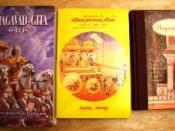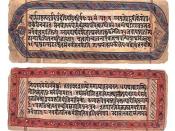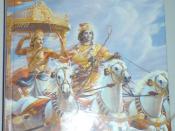The Bhagavad-Gita is a Hindu religious book. The ideas in it are simple and few, just like Hinduism seems to be. The overriding idea is that nothing exists but Brahman, the essence of life. Everything else exists only as a dream, not reality. We are but dream figures. Brahman, which is pure awareness, when seen through fear, ignorance and desire is what creates this dream world.
There are three gunas, or strands of being. The first is sattwa, which is the strand of ideals, it is philosophical, blue light belongs to it, and is composed mostly of the priestly caste. Next is rajas, the strand of energy and emotion, yellow light, and the nobles and warriors. Finally, there is tamas. Tamas is the strand of matter and inertia, the light of red, composed of the spiritually lazy.
The atman, or souls, are constantly reincarnated. It is one big circle of death and rebirth.
There never was a beginning, and there never will be an end. A soul is constantly reborn, according to the karma of their past life, to one of the four major castes. Their behavior dictates their karma, good or bad, and from that, the level of caste they belong to in their next life. Marriage and association between castes is expressly forbidden, and causes one to be an untouchable, or the lowest form not fit to be part of any caste.
The way to enlightenment, or release from the never-ending circle, is by way of one of the yoga, or forms of discipline dictated by Ishwara, or God in human form, or by one of his other names. The disciplines are those of knowledge, karma, renunciation, meditation, mysticism, and devotion. To fully dedicate oneself to one of the forms, and to find Brahman through it,


